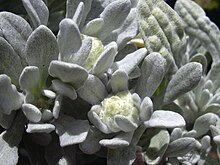| Gnaphalium | |
|---|---|

| |
| Scientific classification | |
| Kingdom: | Plantae |
| Clade: | Tracheophytes |
| Clade: | Angiosperms |
| Clade: | Eudicots |
| Clade: | Asterids |
| Order: | Asterales |
| Family: | Asteraceae |
| Subfamily: | Asteroideae |
| Tribe: | Gnaphalieae |
| Genus: | Gnaphalium L. (1753) not Adans. (1763) |
| Type species | |
| Gnaphalium luteoalbum[1][2] | |
| Synonyms[3] | |
| |
Gnaphalium is a genus of flowering plants in the family Asteraceae,[2][4] commonly called cudweeds or (formerly) chafeweeds. They are widespread and common in temperate regions, although some are found on tropical mountains or in the subtropical regions of the world.
- ^ lectotype designated by Britton & Brown, Illustrated Flora of North America 3: 453. 1913
- ^ a b Tropicos, Gnaphalium L.
- ^ Flann, C (ed) 2009+ Global Compositae Checklist search for Gnaphalium
- ^ Linnaeus, Carl von. 1753. Species Plantarum 2: 850-857 in Latin